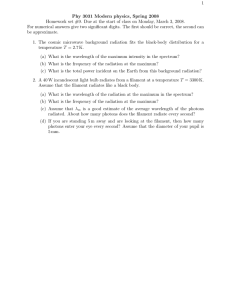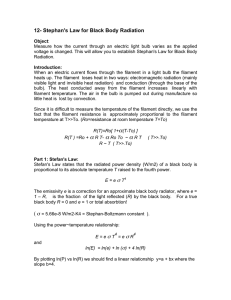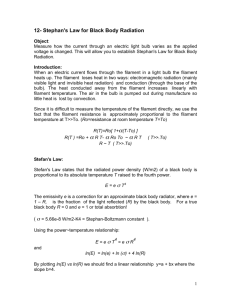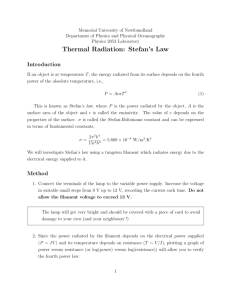Stefan`s Law of Radiation 1.Introduction
advertisement
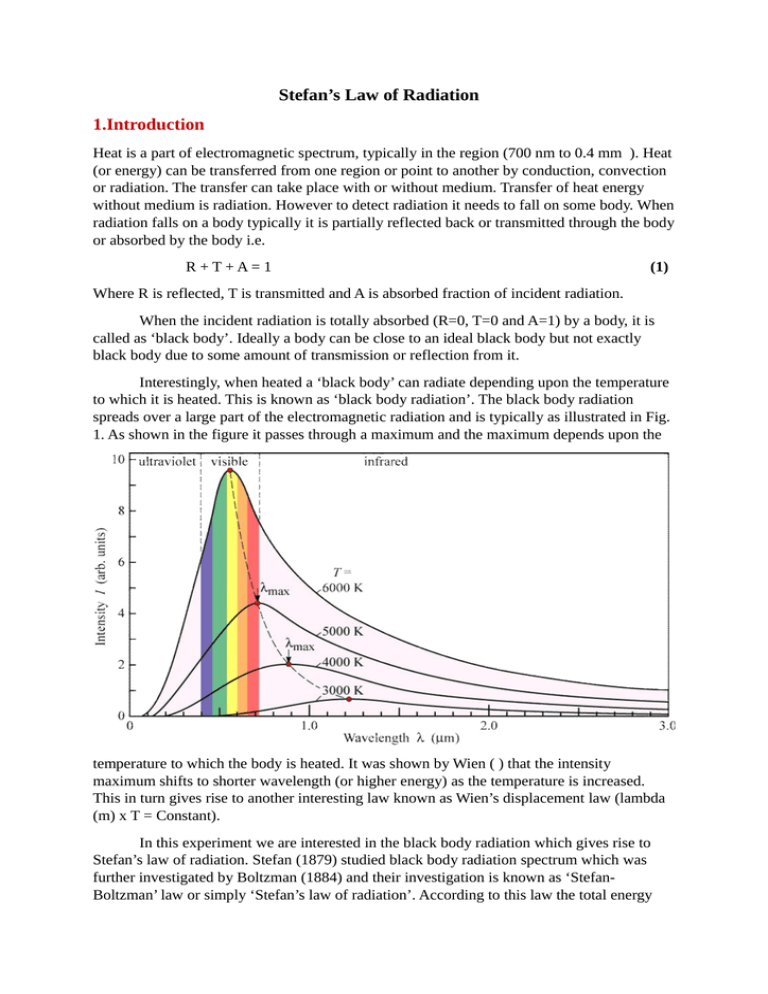
Stefan’s Law of Radiation 1.Introduction Heat is a part of electromagnetic spectrum, typically in the region (700 nm to 0.4 mm ). Heat (or energy) can be transferred from one region or point to another by conduction, convection or radiation. The transfer can take place with or without medium. Transfer of heat energy without medium is radiation. However to detect radiation it needs to fall on some body. When radiation falls on a body typically it is partially reflected back or transmitted through the body or absorbed by the body i.e. R+T+A=1 (1) Where R is reflected, T is transmitted and A is absorbed fraction of incident radiation. When the incident radiation is totally absorbed (R=0, T=0 and A=1) by a body, it is called as ‘black body’. Ideally a body can be close to an ideal black body but not exactly black body due to some amount of transmission or reflection from it. Interestingly, when heated a ‘black body’ can radiate depending upon the temperature to which it is heated. This is known as ‘black body radiation’. The black body radiation spreads over a large part of the electromagnetic radiation and is typically as illustrated in Fig. 1. As shown in the figure it passes through a maximum and the maximum depends upon the temperature to which the body is heated. It was shown by Wien ( ) that the intensity maximum shifts to shorter wavelength (or higher energy) as the temperature is increased. This in turn gives rise to another interesting law known as Wien’s displacement law (lambda (m) x T = Constant). In this experiment we are interested in the black body radiation which gives rise to Stefan’s law of radiation. Stefan (1879) studied black body radiation spectrum which was further investigated by Boltzman (1884) and their investigation is known as ‘StefanBoltzman’ law or simply ‘Stefan’s law of radiation’. According to this law the total energy emitted by an ideal black body P is proportional to the fourth power of absolute temperature T as P = σ T4 (W/m2) (2) Where σ is the proportionality constant and known as ‘Stefan’s constant. The value of σ = 5.669 x 10-8 W/m2. In this experiment tungsten filament of the electric bulb which can be heated to a very high temperature by passing a current into it is considered as a ‘black body’. 2. Objective Aim of the present experiment is to verify the Stefan-Boltzman law viz. equation no. (2). 3. Equipment Schematic diagram of the experimental set up as well as theactual photograph are shown in Fig. 1 (a) and (b) respectively. The equipment consists of (1) Electric bulb with tungsten filament (2) Voltage Source ( 15 V max) (3) Multimeter (Current in ampere) 4. Practical considerations In principle, according to equation 2, in order to determine the Stefan’s constant we need to only determine the energy radiated by the filament and its temperature. However, we are not having a perfect black body and we need to remember that even a tungsten filament cannot be considered as an ideal black body. Every material has different ability to emit radiation and is known as ‘emissivity’. Emissivity (ε) can have a value between 0 and 1. It is the ratio of emission from the material to emission from a perfect black body. Therefore, the power radiated by an imperfect black body will be given by P = σ ε T4 (W/m2) (3) Besides the temperature rise of the body temperature will also depend on the temperature of the surrounding Ts. The material (tungsten filament in this case) not only emits the radiation but also absorbs the radiation from the surrounding. Therefore in practice the loss of heat will be given as E = A σ ε (Tγ - Tsγ) (4) Note that we have used in equation (4) the power of T as ‘γ’ instead of ‘4’ as we want to verify if the radiated power as given by Stefan law is ‘4’ or not in case of the present conditions. Put, A σ ε = C and neglecting Ts (as it can be much smaller than heated filament temperature) E = C Tγ (5) The temperature of the filament depends upon the electric power and therefore the radiated power of the filament depends upon the voltage (V) and current (I) passing through it. Thus E = V.I (6) In order to prove the relation E = σT4, we want to know power radiated E at each temperature T. When we increase the temperature of the filament by increasing the voltage (and corresponding rise in current) power E can be obtained easily at each voltage from the equation (4) below. In order to know ‘T’, we need to know the value of ‘t’ which is T=t+273 (K), we find ‘t’ using equation (8) (1) Rg = resistance of the filament when it glows = (Ω) (7) (2) Note that the resistance is a function of temperature. In case of metals the resistance of a given piece of metal increases with increase of temperature. Resistance of the filament at temperature ‘t’ can be written as Rt and given as Rt = Ro (1+α t +βt2) (8) Rt and Ro are the resistances at temperature ‘t’ and ‘0’ oC respectively. It is known that the temperature at which the tungsten glows is tg = 527 oC. (9) (4)Knowing Rg from equation and putting t as tg (=527 oC) with α= 5.21x10-3 /oC and β = 7.21x10-7/ oC2 Ro = (10) (5) Finally (11) and Thus equation T = t + 273 in K (9) 5. Procedure (1) Measure the resistance of the tungsten at room temperature (Ro) filament of the bulb using the multimeter. (2) Connect the bulb to the voltage source with a voltmeter (multimeter) in parallel and an ammeter (multimeter) in series. (3) Keep the voltage control knob of the power supply to minimum and current control knob to maximum. (4) Switch on the power supply and note down the current and voltage in table 1as given below. (5) Increase the voltage through steps of ~ 0.5V till the filament just begins to glow. At each voltage (V) increase step note down the corresponding current (I). The voltage and current at which the filament just begins to glow are Vg and Ig respectively. (6)Voltage can be increased further upto maximum ~ 10.0 V and corresponding current noted at each voltage step. Table 1 : 6. Results and Analysis 1) Plot a graph of ln E versus ln T and find out ‘γ’. It should be close to ‘4’ which will prove Stefan’s law. 7. Reference: LEYBOLD Manual?
